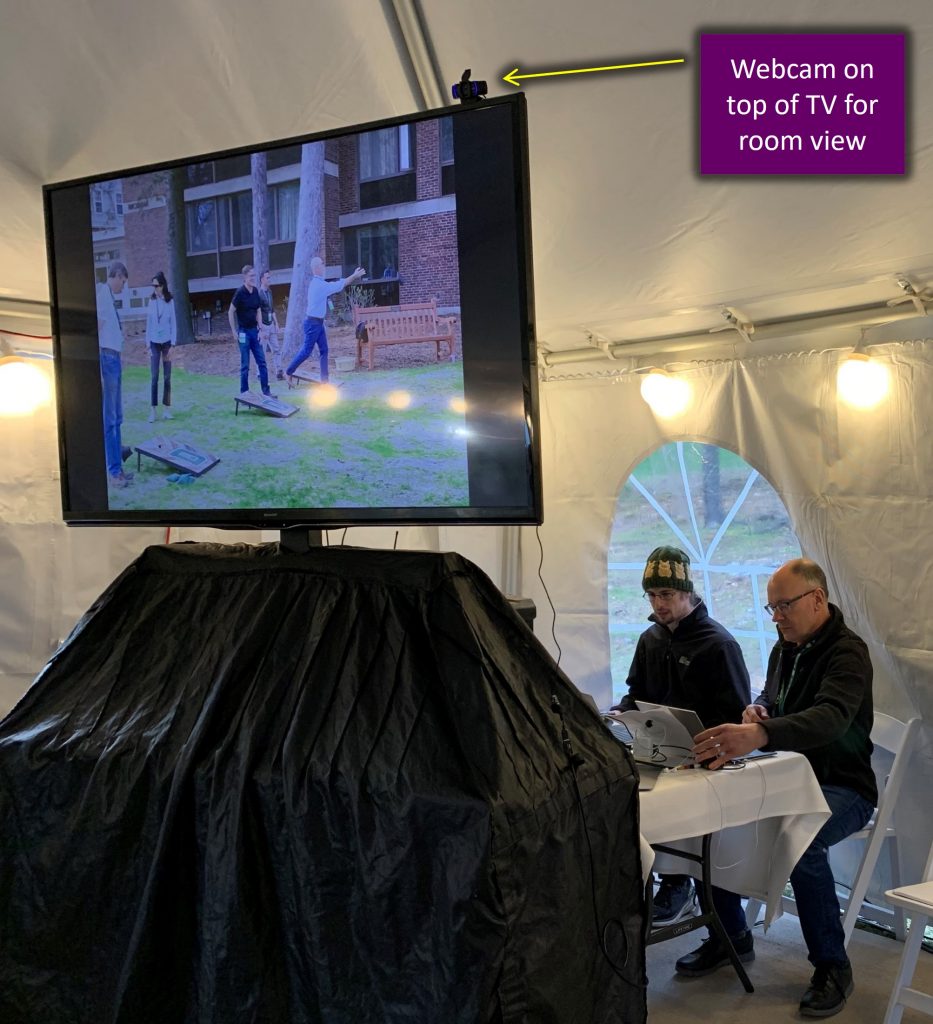This article shares one of the lessons I learned when planning and running a hybrid class reunion event in May 2022. Read the introduction and see the other lessons in this series here.
Lesson
One of the issues I identified early in planning for the hybrid reunion event was that I wanted the people attending remotely to see everyone in the room and be able to see the people speaking during the program. I couldn’t have a single camera do both and I didn’t have a camera operator to move and zoom a camera.
I used two cameras. One was a webcam attached to one of the laptops. This was mounted high on top of one of the 70-inch TVs and it showed almost the entire room.

This allowed the remote attendees to feel like they were in the room with everyone in the tent. The second camera was an iPad on a tripod that was aimed at the front of the room where the people would be speaking during the program. This allowed the remote attendees to be able to see the speakers better during the program.
I had the iPad connected to the Zoom meeting as a separate participant. This allowed me to be able to have both video feeds in the meeting at the same time. I didn’t have to switch cameras on one laptop. Having two cameras also allowed me to be able to spotlight either one so everyone attending remotely had a larger view of what was going on in the room or of the speakers during the program.
Applying this lesson to your meetings
Use an iPad or phone as a second camera
Connect an iPad or phone as a second camera to give the virtual meeting two views of the room. Use a tripod (here’s the one I prefer) and a holder for the phone or iPad (here’s the iPad holder I use). This camera can be aimed at the room or the presenter. Change the display name in the Zoom meeting to reflect the view of the camera. This makes it easier for you and the attendees to know what the camera is showing.
Connect the device as a separate attendee in the meeting. This allows for flexibility in usage of the video feed. Turn off the mic and speakers on the device so it does not interfere with the audio feed from the room.
Consider plugging the device into a power supply or battery so it does not run out of power during the meeting (this battery has a good balance of power and size). Transmitting video is a power drain on devices and you don’t want it to shut down during the meeting.
(Here’s a list of other hybrid meeting room equipment I recommend)
Use a second webcam on your laptop
You may not want to or be able to set up a second device in the meeting room. In that case, consider a second webcam for your laptop. You can use the built-in webcam to point to the presenter and have an external webcam (I use a Logitech C920) to point to the room. I still suggest a small tripod for the external webcam as it gives more flexibility in aiming the camera. With two webcams on one device you will need to switch which camera is being used in the virtual platform when you want to show the room or the presenter. You can’t have both cameras in the meeting at the same time.
Use Spotlight to have a camera full screen
When you want to focus the audience on a specific view, use the Spotlight feature of Zoom or Teams to make that video feed full screen for all the virtual attendees. This is a good way to make them feel like they are in the room with everyone else. If you are sharing content like slides, the spot lit video will be slightly larger than other videos and won’t replace the shared content.
Each virtual attendee can choose to pin a video to make it larger on their own screen only. Let people know they can do this so that they have some control of the view of the room they have during the meeting.
Wrapup
In a hybrid meeting we need to address the different views of the room for the virtual participants. Consider a second camera to give you and the virtual attendees options of what they see in the room.

Dave Paradi has over twenty-two years of experience delivering customized training workshops to help business professionals improve their presentations. He has written ten books and over 600 articles on the topic of effective presentations and his ideas have appeared in publications around the world. His focus is on helping corporate professionals visually communicate the messages in their data so they don’t overwhelm and confuse executives. Dave is one of fewer than ten people in North America recognized by Microsoft with the Most Valuable Professional Award for his contributions to the Excel, PowerPoint, and Teams communities. His articles and videos on virtual presenting have been viewed over 4.8 million times and liked over 17,000 times on YouTube.
